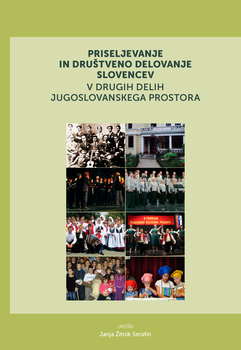Priseljevanje in društveno delovanje Slovencev v drugih delih jugoslovanskega prostora. Zgodovinski oris in sedanjost
Immigration of Slovenians to other areas of the former Yugoslavia and their organization of ethnic societies there is a subject of research that became interesting for researchers in the field of international migration studies only after the disintegration of the former Yugoslavia. Compared to the research into Slovenian immigration to other countries and continents, this subject had been neglected for decades. The book ('Slovenian Immigration and Society Activities across the Former Yugoslavia: Historical Outline and the Present') is divided into three chronological parts: Historical Outline, Between the Past and the Present, and The Current Situation. In this book, the data and findings of previous research are revised, upgraded and completed by the results of the authors' own archival and statistical research as well as extensive fieldwork (questionnaire, half-structured interviews, meetings/roundtables, informal interviews, observation with participation), carried out in the framework of two research projects.
In the opening part entitled "Historical Outline", the book first summarizes the political history of the former Yugoslavia (and more broadly the Balkans), and then focuses on the immigration of Slovenians to other parts of the former Yugoslavia and their organization of ethnic societies there. An analysis of their census numbers in given areas between 1880 and 2012 is followed by the discussion of their main emigration, seasonal work and return-migration flows before and after the Second World War. The first part of the book ends with a historical overview of the foundation and operation of Slovenian cultural societies and associations in other parts of the so-called "Yugoslav area" from their earliest organized forms in the 19th century to their heyday after the disintegration of socialist Yugoslavia. The second part of the book entitled "Between the Past and the Present" discusses the evacuation of Slovenians from the war-time Sarajevo in November 1992 through their intimate experience of the war trauma and their often fatal choice between two alternative options: to leave or to stay. The focus of the last part of the book is on the current situation and it falls into three consecutive chapters. The first analyses the disproportion between the census numbers of the Slovenians in the discussed areas and the numerical data about the membership in the Slovenian cultural societies in these same areas, explaining why their membership numbers often exceed their census numbers. This is followed by an examination of the socio-cultural connotations (economic, emotional, symbolic, identification, etc.) of the Slovenian language in other parts of the former Yugoslavia, where the status of this language was changing throughout the recent history until it became more significant with the independence of Slovenia and its membership in the EU. The book ends with a chapter on the current activities of the Slovenian cultural societies and associations in the discussed areas, and on the importance of vital integration of these activities not only within the contemporary cultural production of Slovenia proper but also in the multicultural local environment in which these societies operate.
Downloads

Series
License

This work is licensed under a Creative Commons Attribution-NonCommercial-NoDerivatives 4.0 International License.
